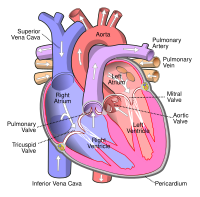
Photo from wikipedia
Aim & objective To report mid-term follow-up result of transcatheter closure of perimembranous Ventricular septal defect (VSD) in children weighing less than 10 kg using Amplatzer Duct Occlude-I (ADO-I) by… Click to show full abstract
Aim & objective To report mid-term follow-up result of transcatheter closure of perimembranous Ventricular septal defect (VSD) in children weighing less than 10 kg using Amplatzer Duct Occlude-I (ADO-I) by left ventricular (LV) mid-cavity approach. Material & method This is retrospective review of 35 children weighing less than 10 kg with moderate to large perimembranous VSD who were selected for transcatheter closure of VSD using ADO-I in between October 2016 to September 2018. Mean age was 2.08 ± 0.67 years (mean ± SD) and mean weight was 7.2 ± 1.2 kg (mean ± SD). Procedure was done by crossing the VSD from right ventricular side instead of using the standard approach by forming arterio-venous loop. Average fluoroscopic time was 9.2 ± 2.9 min (mean ± SD) and mean procedure time was 34.1 ± 13.1 min (mean ± SD). Mean follow-up period was 8.7 months (3–12 months) Result Device closure was successfully done in 32 patients. There was device induced aortic regurgitation (AR) in one case who was sent for surgery. One child was found to have complete heart block on first post-procedure day requiring permanent pace-maker implantation. During follow up none of them had any residual VSD, rhythm disturbance, AR and left or right ventricular outflow obstruction. Conclusion Device closure can be successfully done in moderate to large perimembranous VSD using left ventricular mid cavity approach in small children. LV mid-cavity approach has advantages in terms of lesser hemodynamic instability, lesser fluoroscopy and lesser chance of device induced AR than standard technique particularly in smaller children.
Journal Title: Indian Heart Journal
Year Published: 2020
Link to full text (if available)
Share on Social Media: Sign Up to like & get
recommendations!